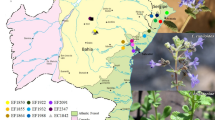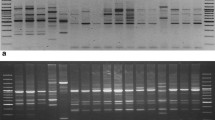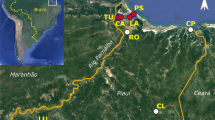Abstract
The genetic diversity of Spanish and French field populations of Monilinia fructicola, a quarantine fungal pathogen in Europe, was compared with that of Californian, Uruguayan, and New Zealand M. fructicola populations using inter simple sequence repeat (ISSR) and random amplified polymorphic DNA (RAPD) markers. Unweighted pair-group method with arithmetic average (UPGMA) cluster analysis and principal component analysis (PCA) of the ISSR data set revealed that the Spanish and French M. fructicola isolates were more closely related between themselves than to the non-European isolates. The levels of genetic diversity in the Spanish and French isolates are lower than those of the non-European isolates, indicating that M. fructicola is a recently introduced pathogen. UPGMA cluster analysis and PCA of the combined ISSR + RAPD data set of the European M. fructicola populations revealed that the Spanish isolates were more closely related among themselves than with the French isolates. Analysis of molecular variance partitioned the genetic variance to among the two regions (Spain and France) (20%), among the regional populations (35%), and within the populations in each region (45%) suggesting restricted gene flow between the three European populations. The observed index of association (IA) in each European M. fructicola populations indicates that the French and Spanish populations of M. fructicola are mainly asexually reproducing, with the Sudanell population potentially having a teleomorphic stage. The present finding of low genetic diversity in the Spanish and French M. fructicola populations is probably due to founder effects and genetic drift.


Similar content being viewed by others
References
Agapow, P. M., & Burt, A. (2001). Indices of multilocus linkage disequilibrium. Molecular Ecology Notes, 1, 101–102.
Byrde, R. J., & Willetts, H. J. (1977). The brown rot fungi of fruit - Their biology and control. Oxford: Pergamon Press.
De Cal, A., & Melgarejo, P. (1999). Effects of long-wave UV light on Monilinia growth and identification of species. Plant Disease, 83, 62–65.
De Cal, A., Gell, I., Usall, J., Viñas, I., & Melgarejo, P. (2009). First report of brown rot caused by Monilinia fructicola in peach orchards in Ebro Valley, Spain. Plant Disease, 93, 763.
Duchoslavová, J., Sirucková, I., Zapletalová, E., Navratil, M., & Safarova, D. (2007). First report of brown rot caused by Monilinia fructicola on various stone and pome fruits in the Czech Republic. Plant Disease, 91, 907.
EPPO. (2006). Monilinia fructicola. Distribution maps of quarantine pest of Europe http://www.eppo.org/QUARANTINE/fungi/Monilinia_fructicola/MONIFC_map.htm.
EPPO. (2007). List of A2 pests regulated as quarantine pests in the EPPO region. OEPP/EPPO from http://www.eppo.org/QUARANTINE/listA2.htm.
Fan, J. Y., Guo, L.-Y., Xu, J. P., Luo, Y., & Michailides, T. J. (2010). Genetic diversity of populations of Monilinia fructicola (Fungi, Ascomycota, Helotiales) from China. The Journal of Eukaryotic Microbiology, 57, 206–212.
Free, S. J., Holtz, B. A., & Michailides, T. J. (1996). Mating behavior in field populations of Monilinia fructicola in California. Mycologia, 88, 208–211.
Fulton, C. E., van Leeuwen, G. C. M., & Brown, A. E. (1999). Genetic variation among and within Monilinia species causing brown rot of stone and pome fruits. European Journal of Plant Pathology, 105, 495–500.
Gagné, P., Yang, D. Q., Hamelin, R. C., & Bermier, L. (2001). Genetic variability of Canadian populations of the sapstain fungus Ophiosthoma piceae. Phytopathology, 91, 369–376.
Gell, I., Larena, I., & Melgarejo, P. (2007a). Genetic diversity in Monilinia laxa populations in peach orchards in Spain. Journal of Phytopathology, 155, 549–556.
Gell, I., Cubero, J., & Melgarejo, P. (2007b). Two different PCR approaches for universal diagnosis of brown rot and identification of Monilinia spp. in stone fruit trees. Journal Applied Microbiology, 103, 2629–2637.
Gell, I., De Cal, A., Torres, R., Usall, J., & Melgarejo, P. (2008). Relationship between the incidence of latent infections caused by Monilinia spp. and the incidence of brown rot of peach fruit: Factors affecting latent infection. European Journal of Plant Pathology, 121, 487–498.
Goodwin, S. B., Sielman, L. J., Matuszak, J. M., Bergeron, S. N., & Fry, W. E. (1992). Clonal diversity and genetic differentiation of Phytophthora infestans populations in northern and central Mexico. Phytopathology, 82, 955–961.
Goodwin, S. B., Saghai Maroof, M. A., Allard, R. W., & Webster, R. K. (1993). Isozyme variation within and among populations of Rhynchosporium secalis in Europe, Australia and the United States. Mycological Research, 97, 49–58.
Groppe, K., Sanders, I., Wiemken, A., & Boller, T. (1995). A microsatellite marker for studying the ecology and diversity of fungal endophytes (Epichlöe spp.) in grasses. Applied and Environmental Microbiology, 61, 3943–3949.
Grünwald, N. J., Goodwin, S. B., Milgroom, M. G., & Fry, W. E. (2003). Analysis of genotypic diversity data for populations of microorganisms. Phytopathology, 93, 738–746.
Hilber-Bodmer, M., Bünter, M., & Patocchi, A. (2010). First report of brown rot caused by Monilinia fructicola on apricot in a Swiss orchard. Plant Disease, 94, 643.
Holtz, B. A., Michailides, T. J., & Hong, C. X. (1998). Development of apothecia from stone fruit infected and stromatized by Monilinia fructicola in California. Plant Disease, 82, 1375–1380.
Jana, T., Sharma, T. R., & Singh, N. K. (2005). SSR-based detection of genetic variability in the charcoal root rot pathogen Macrophomina phaseolina. Mycological Research, 109, 81–86.
Lichou, J., Mandrin, J. F., Breniaux, D., Mercier, V., Giauque, P., Desbrus, D., et al. (2002). Une nouvelle moniliose. Phytoma, 547, 22–25.
Lim, S., Notley-McRobb, L., Lim, M., & Carter, D. A. (2004). A comparison of nature and abundance of microsatellite in 14 fungal genomes. Fungal Genetics and Biology, 41, 1025–1036.
Liu, Y.-C., Cortesi, P., Double, M. L., MacDonald, W. L., & Milgroom, M. G. (1996). Diversity and multilocus genetic structure in populations of Cryphonectria parasitica. Phytopathology, 86, 1344–1351.
Longato, S., & Bonfante, P. (1997). Molecular identification of mycorrhizal fungi by direct amplification of microsatellite regions. Mycological Research, 101, 425–432.
Ma, Z., & Michailides, T. J. (2005). Genetic structure of Botrytis cinerea populations from different host plants in California. Plant Disease, 89, 1083–1089.
Ma, Z., Yoshimura, M. A., & Michailides, T. J. (2003a). Identification and characterization of benzimidazole resistance in Monilinia fructicola from stone fruit orchards in California. Applied and Environmental Microbiology, 39, 7145–7152.
Ma, Z., Luo, Y., & Michailides, T. J. (2003b). Nested PCR assays for detection of Monilinia fructicola in stone fruit orchards and Botryosphaeria dothidea from pistachios in California. Journal of Phytopathology, 151, 312–322.
McDonald, B. (1997). The population genetics of fungi: Tools and techniques. Phytopathology, 87, 448–453.
Milgroom, M. G., Lipari, S. E., & Wang, K. (1992). Comparison of genetic diversity in the chestnut blight fungus, Cryphonectria (Endothia) parasitica, from China and the US. Mycological Research, 96, 1114–1120.
Moyano, C., Alfonso, C., Gallego, J., Raposo, R., & Melgarejo, P. (2003). Comparison of RAPD and AFLP markers analysis as a means to study the genetic structure of Botrytis cinerea populations. European Journal of Plant Pathology, 109, 515–522.
Munda, A., & Virscek Marn, M. (2010). First report of brown rot caused by Monilinia fructicola affecting peach orchards in Slovenia. Plant Disease, 94, 1166.
Nei, M. (1973). Analysis of genetic diversity in subdivided populations. Proceedings of the National Academy of Sciences of USA, 70, 3321–3323.
Nei, M. (1978). Estimation of average heterozygosity and genetic distance from a small number of individuals. Genetics, 89, 583–590.
Nei, M., Maruyama, T., & Chakraborty, R. (1975). The bottleneck effect and genetic variability in populations. Evolution, 29, 1–10.
Peakall, R., & Smouse, P. E. (2006). GENALEX 6: Genetic analysis in Excel. Population genetic software for teaching and research. Molecular Ecology Notes, 6, 288–295.
Pellegrino, C., Gullino, M. L., Garibaldi, A., & Spadaro, D. (2009). First report of brown rot of stone fruit caused by Monilinia fructicola in Italy. Plant Disease, 93, 668.
Rohlf, F. J. (1993). Contributions to morphometrics: Relative warp analysis and an example of its application to mosquito wings. In Marcus et al. (Eds.), Museo Nacional de Ciencias Naturales (pp. 131–159). Madrid.
Rohlf, F. J., & Sokal, R. R. (1981). Comparing numerical taxonomic studies. Systematic Zoology, 30, 459–490.
Scherm, H., & Emery, K. M. (2003). Vegetative compatibility in populations of Monilinia fructicola from Georgia peach orchards. Acta Horticulturae, 592, 725–728.
Sica, M., Gamba, G., Montieri, S., Gaudio, L., & Aceto, S. (2005). ISSR markers show differentiation among Italian populations of Asparagus acutifolius L. BMC Genetics, 6, 17.
Sneath, P. H. A., & Sokal, R. R. (1973). Numerical taxonomy—the principles and practice of numerical classification. San Francisco: W. H. Freeman.
Villarino, M., Melgarejo, P., Usall, J., Segarra, J., & De Cal, A. (2010). Primary inoculum sources of Monilinia spp. in Spanish peach orchards and their relative importance in brown rot. Plant Disease, 94, 1048–1054.
Weger, J., Schanze, M., Hilber-Bodmer, M., Smits, T. H. M., & Patocchi, A. (2011). First report of the β-tubulin E198A Mutation conferring resistance to methyl benzimidazoles carbamates in European isolates of Monilinia fructicola. Plant Disease, 95, 497.
Wright, S. (1951). The genetical structure of populations. Annual Eugene, 15, 323–354.
Zhong, Y. F., Zhang, Y. W., Chen, X. Y., Luo, Y., & Guo, L. Y. (2008). Overwintering of Monilinia fructicola in Stone Fruit Orchards in Northern China. Journal of Phytopathology, 156, 229–235.
Zhou, S., Smith, D. R., & Stanosz, G. R. (2001). Differentiation of Botryosphaeria species and related anamorphic fungi using Inter Simple or Short Sequence Repeat (ISSR) fingerprinting. Mycological Research, 105, 919–926.
Acknowledgements
We thank Dr. T. Michailides (University of California, Davis, USA), Dr. P. Mondino (Facultad de Agronomía. Universidad de la República de Uruguay, Uruguay), and Dr. P. Elmer (New Zealand Institute for Plant & Food Research Limited. Hamilton New Zealand) for kindly providing isolates of M. fructicola. The authors are grateful to Dr. J. Gallego, Dr. J. Ibañez, Dr. C. Rodriguez, and Dr. R. Arroyo for making helpful comments on earlier drafts of this manuscript. The authors also wish to thank Dr. A. Bomzon, Consulwrite (www.consulwrite.com) for his editorial assistance in preparing this manuscript. This study was supported by grant AGL2008-00341-CO2 from the Ministry of Science and Innovation (Spain). M. Villarino received a scholarship from INIA (Spain). We thank R. Castillo and Postharvest Unit (Centre UdL-IRTA, Lleida, Spain) for their support and collaboration.
Author information
Authors and Affiliations
Corresponding author
Rights and permissions
About this article
Cite this article
Villarino, M., Larena, I., Martinez, F. et al. Analysis of genetic diversity in Monilinia fructicola from the Ebro Valley in Spain using ISSR and RAPD markers. Eur J Plant Pathol 132, 511–524 (2012). https://doi.org/10.1007/s10658-011-9895-y
Accepted:
Published:
Issue Date:
DOI: https://doi.org/10.1007/s10658-011-9895-y




